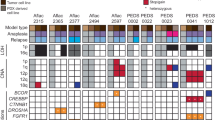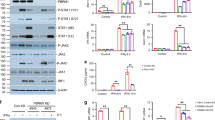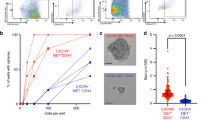Abstract
Wilms’ tumor (WT), the most frequent renal solid tumor in children, has been linked to aberrant Wnt signaling. Herein, we demonstrate that different WTs can be grouped according to either sensitivity or resistance to an antibody (Ab) specific to frizzled7 (FZD7), a Wnt receptor. In the FZD7-sensitive WT phenotype, the Ab induced cell death of the FZD7+ fraction, which in turn depleted primary WT cultures of their clonogenic and sphere-forming cells and decreased in vivo proliferation and survival on xenografting to the chick chorio-allantoic-membrane. In contrast, FZD7-resistant WT in which no cell death was induced showed a different intra-cellular route of the Ab-FZD7 complex compared with sensitive tumors and accumulation of β-catenin. This coincided with a low sFRP1 and DKK1 (Wnt inhibitors) expression pattern, restored epigenetically with de-methylating agents, and lack of β-catenin or WTX mutations. The addition of exogenous DKK1 and sFRP1 to the tumor cells enabled the sensitization of FZD7-resistant WT to the FZD7 Ab. Finally, although extremely difficult to achieve because of dynamic cellular localization of FZD7, sorting of FZD7+ cells from resistant WT, showed them to be highly clonogenic/proliferative, overexpressing WT ‘stemness’ genes, emphasizing the importance of targeting this fraction. FZD7 Ab therapy alone or in combination with Wnt pathway antagonists may have a significant role in the treatment of WT via targeting of a tumor progenitor population.
This is a preview of subscription content, access via your institution
Access options
Subscribe to this journal
Receive 50 print issues and online access
$259.00 per year
only $5.18 per issue
Buy this article
- Purchase on Springer Link
- Instant access to full article PDF
Prices may be subject to local taxes which are calculated during checkout










Similar content being viewed by others
References
Bao S, Wu Q, McLendon RE, Hao Y, Shi Q, Hjelmeland AB et al. (2006). Glioma stem cells promote radioresistance by preferential activation of the DNA damage response. Nature 444: 756–760.
Barker N, Clevers H . (2006). Mining the Wnt pathway for cancer therapeutics. Nat Rev Drug Discov 5: 997–1014.
Clarke MF, Dick JE, Dirks PB, Eaves CJ, Jamieson CH, Jones DL et al. (2006). Cancer stem cells—perspectives on current status and future directions: AACR Workshop on cancer stem cells. Cancer Res 66: 9339–9344.
Dekel B, Metsuyanim S, Schmidt-Ott KM, Fridman E, Jacob-Hirsch J, Simon A et al. (2006a). Multiple imprinted and stemness genes provide a link between normal and tumor progenitor cells of the developing human kidney. Cancer Res 66: 6040–6049.
Dekel B, Zangi L, Shezen E, Reich-Zeliger S, Eventov-Friedman S, Katchman H et al. (2006b). Isolation and characterization of nontubular sca-1+lin- multipotent stem/progenitor cells from adult mouse kidney. J Am Soc Nephrol 17: 3300–3314.
Deryugina EI, Quigley JP . (2008). Chick embryo chorioallantoic membrane model systems to study and visualize human tumor cell metastasis. Histochem Cell Biol 130: 1119–1130.
Feinberg AP, Williams BR . (2003). Wilms’ tumor as a model for cancer biology. Methods Mol Biol 222: 239–248.
Fillmore CM, Kuperwasser C . (2008). Human breast cancer cell lines contain stem-like cells that self-renew, give rise to phenotypically diverse progeny and survive chemotherapy. Breast Cancer Res 10: R25.
Galmozzi E, Facchetti F, La Porta CA . (2006). Cancer stem cells and therapeutic perspectives. Curr Med Chem 13: 603–607.
Geenen MM, Cardous-Ubbink MC, Kremer LC, van den Bos C, van der Pal HJ, Heinen RC et al. (2007). Medical assessment of adverse health outcomes in long-term survivors of childhood cancer. JAMA 297: 2705–2715.
Giles RH, van Es JH, Clevers H . (2003). Caught up in a Wnt storm: Wnt signaling in cancer. Biochim Biophys Acta 1653: 1–24.
Jost E, Schmid J, Wilop S, Schubert C, Suzuki H, Herman JG et al. (2008). Epigenetic inactivation of secreted Frizzled-related proteins in acute myeloid leukaemia. Br J Haematol 142: 745–753.
Katoh M, Katoh M . (2007). WNT signaling pathway and stem cell signaling network. Clin Cancer Res 13: 4042–4045.
Koesters R, Ridder R, Kopp-Schneider A, Betts D, Adams V, Niggli F et al. (1999). Mutational activation of the beta-catenin proto-oncogene is a common event in the development of Wilms’ tumors. Cancer Res 59: 3880–3882.
Li CM, Guo M, Borczuk A, Powell CA, Wei M, Thaker HM et al. (2002). Gene expression in Wilms’ tumor mimics the earliest committed stage in the metanephric mesenchymal-epithelial transition. Am J Pathol 160: 2181–2190.
Maiti S, Alam R, Amos CI, Huff V . (2000). Frequent association of beta-catenin and WT1 mutations in Wilms tumors. Cancer Res 60: 6288–6292.
Major MB, Camp ND, Berndt JD, Yi X, Goldenberg SJ, Hubbert C et al. (2007). Wilms tumor suppressor WTX negatively regulates WNT/beta-catenin signaling. Science 316: 1043–1046.
Metsuyanim S, Harari-Steinberg O, Buzhor E, Omer D, Pode-Shakked N, Ben-Hur H et al. (2009). Expression of stem cell markers in the human fetal kidney. PLoS One 4: e6709.
Metsuyanim S, Pode-Shakked N, Schmidt-Ott KM, Keshet G, Rechavi G, Blumental D et al. (2008). Accumulation of malignant renal stem cells is associated with epigenetic changes in normal renal progenitor genes. Stem Cells 26: 1808–1817.
Moon RT, Kohn AD, De Ferrari GV, Kaykas A . (2004). WNT and beta-catenin signalling: diseases and therapies. Nat Rev Genet 5: 691–701.
Nojima M, Suzuki H, Toyota M, Watanabe Y, Maruyama R, Sasaki S et al. (2007). Frequent epigenetic inactivation of SFRP genes and constitutive activation of Wnt signaling in gastric cancer. Oncogene 26: 4699–4713.
Park JS, Valerius MT, McMahon AP . (2007). Wnt/beta-catenin signaling regulates nephron induction during mouse kidney development. Development 134: 2533–2539.
Pfeiffer P, Qvortrup C, Eriksen JG . (2007). Current role of antibody therapy in patients with metastatic colorectal cancer. Oncogene 26: 3661–3678.
Pode-Shakked N, Metsuyanim S, Rom-Gross E, Mor Y, Fridman E, Goldstein I et al. (2008). Developmental tumorigenesis: NCAM as a putative marker for the malignant renal stem/progenitor cell population. J Cell Mol Med 13: 1792–1808.
Rahman N, Arbour L, Tonin P, Renshaw J, Pelletier J, Baruchel S et al. (1996). Evidence for a familial Wilms’ tumour gene (FWT1) on chromosome 17q12-q21. Nat Genet 13: 461–463.
Rashidi H, Sottile V . (2009). The chick embryo: hatching a model for contemporary biomedical research. Bioessays 31: 459–465.
Ren X, Ye F, Jiang Z, Chu Y, Xiong S, Wang Y . (2007). Involvement of cellular death in TRAIL/DR5-dependent suppression induced by CD4(+)CD25(+) regulatory T cells. Cell Death Differ 14: 2076–2084.
Reya T, Morrison SJ, Clarke MF, Weissman IL . (2001). Stem cells, cancer, and cancer stem cells. Nature 414: 105–111.
Rivera MN, Haber DA . (2005). Wilms’ tumour: connecting tumorigenesis and organ development in the kidney. Nat Rev Cancer 5: 699–712.
Rivera MN, Kim WJ, Wells J, Driscoll DR, Brannigan BW, Han M et al. (2007). An X chromosome gene, WTX, is commonly inactivated in Wilms tumor. Science 315: 642–645.
Robison LL . (2005). The Childhood Cancer Survivor Study: a resource for research of long-term outcomes among adult survivors of childhood cancer. Minn Med 88: 45–49.
Schedl A . (2007). Renal abnormalities and their developmental origin. Nat Rev Genet 8: 791–802.
Schmidt-Ott KM, Barasch J . (2008). WNT/beta-catenin signaling in nephron progenitors and their epithelial progeny. Kidney Int 74: 1004–1008.
Singh SK, Clarke ID, Terasaki M, Bonn VE, Hawkins C, Squire J et al. (2003). Identification of a cancer stem cell in human brain tumors. Cancer Res 63: 5821–5828.
Singh SK, Hawkins C, Clarke ID, Squire JA, Bayani J, Hide T et al. (2004). Identification of human brain tumour initiating cells. Nature 432: 396–401.
Somervaille TC, Cleary ML . (2006). Identification and characterization of leukemia stem cells in murine MLL-AF9 acute myeloid leukemia. Cancer Cell 10: 257–268.
Spreafico F, Pritchard-Jones K, Bergeron C, de Kraker J, Dallorso S, Graf N . (2009). Value and difficulties of a common European strategy for recurrent Wilms’ tumor. Expert Rev Anticancer Ther 9: 693–696.
Suzuki H, Toyota M, Carraway H, Gabrielson E, Ohmura T, Fujikane T et al. (2008). Frequent epigenetic inactivation of Wnt antagonist genes in breast cancer. Br J Cancer 98: 1147–1156.
Taizi M, Deutsch VR, Leitner A, Ohana A, Goldstein RS . (2006). A novel and rapid in vivo system for testing therapeutics on human leukemias. Exp Hematol 34: 1698–1708.
Tropepe V, Sibilia M, Ciruna BG, Rossant J, Wagner EF, van der Kooy D . (1999). Distinct neural stem cells proliferate in response to EGF and FGF in the developing mouse telencephalon. Dev Biol 208: 166–188.
van der Kooy D, Weiss S . (2000). Why stem cells? Science 287: 1439–1441.
Wittmann S, Wunder C, Zirn B, Furtwangler R, Wegert J, Graf N et al. (2008). New prognostic markers revealed by evaluation of genes correlated with clinical parameters in Wilms tumors. Genes Chromosomes Cancer 47: 386–395.
Zirn B, Samans B, Wittmann S, Pietsch T, Leuschner I, Graf N et al. (2006). Target genes of the WNT/beta-catenin pathway in Wilms tumors. Genes Chromosomes Cancer 45: 565–574.
Acknowledgements
We thank Lior Zangi, Tsahi Neuman and Igor Grinberg for technical assistance. This work was supported by ISF grant number 1139/07, ICRF Clinical Career Development Award, TAU Cancer Biology Research Center and TAU Stem Cell Research Center, The Schreiber and Brettler Foundations, Sackler School of Medicine, Tel Aviv University (BD). This work is part of the requirements toward a PhD degree, Sackler School of Medicine, Tel Aviv University (NPS).
Author information
Authors and Affiliations
Corresponding author
Ethics declarations
Competing interests
Naomi Pode-Shakked, Orit Harari-Steinberg and Benjamin Dekel have filed a patent application related to this work.
Additional information
Supplementary Information accompanies the paper on the Oncogene website
Supplementary information
Rights and permissions
About this article
Cite this article
Pode-Shakked, N., Harari-Steinberg, O., Haberman-Ziv, Y. et al. Resistance or sensitivity of Wilms’ tumor to anti-FZD7 antibody highlights the Wnt pathway as a possible therapeutic target. Oncogene 30, 1664–1680 (2011). https://doi.org/10.1038/onc.2010.549
Received:
Revised:
Accepted:
Published:
Issue Date:
DOI: https://doi.org/10.1038/onc.2010.549
Keywords
This article is cited by
-
Synthesis of the scFv fragment of anti-Frizzled-7 antibody and evaluation of its effects on triple-negative breast cancer in vitro study
Clinical and Translational Oncology (2023)
-
A novel humanized Frizzled-7-targeting antibody enhances antitumor effects of Bevacizumab against triple-negative breast cancer via blocking Wnt/β-catenin signaling pathway
Journal of Experimental & Clinical Cancer Research (2021)
-
Disorders of FZ-CRD; insights towards FZ-CRD folding and therapeutic landscape
Molecular Medicine (2020)
-
NCAM1/FGF module serves as a putative pleuropulmonary blastoma therapeutic target
Oncogenesis (2019)
-
Dissecting Stages of Human Kidney Development and Tumorigenesis with Surface Markers Affords Simple Prospective Purification of Nephron Stem Cells
Scientific Reports (2016)



